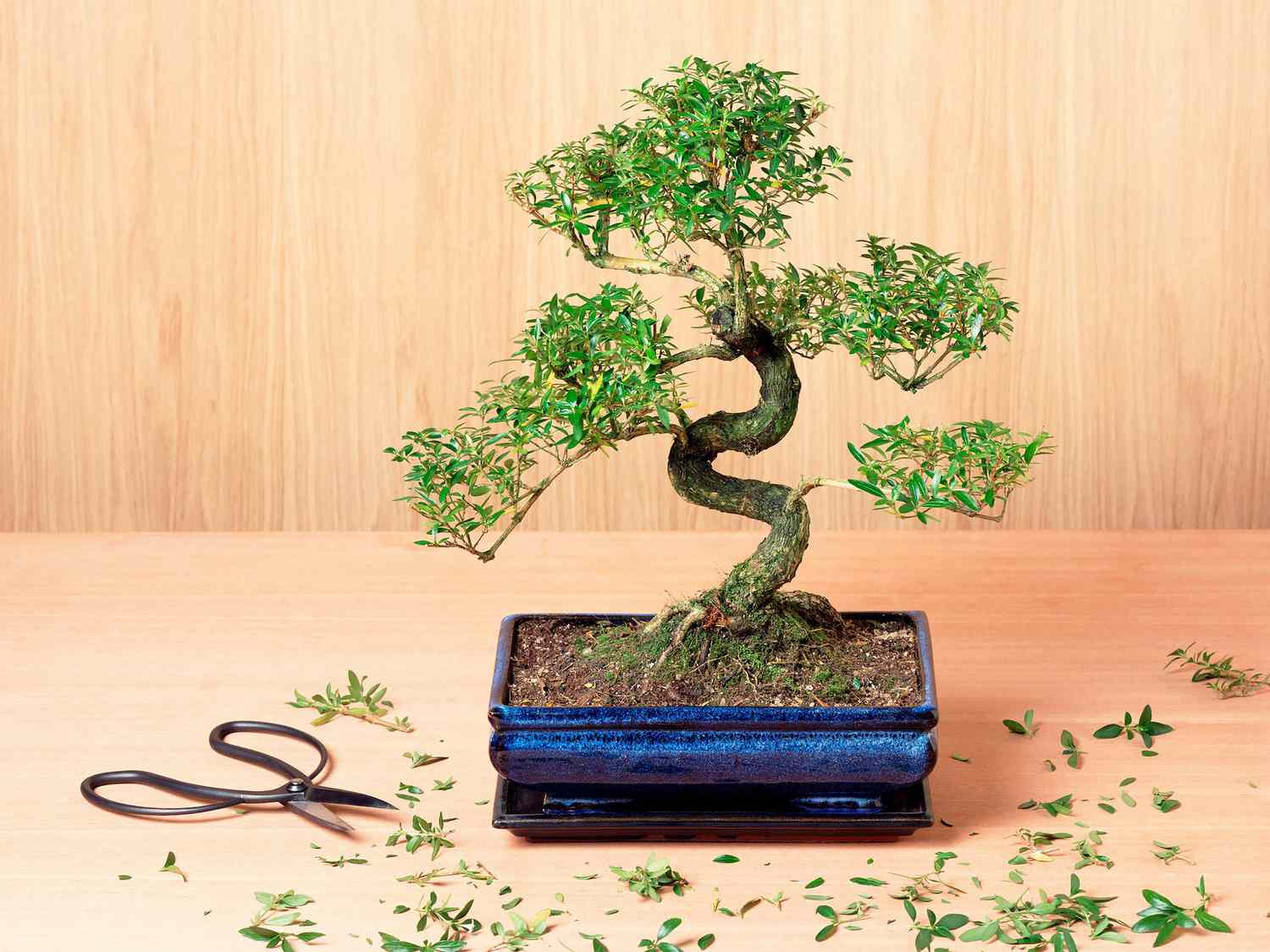Home>Types of Gardening>Ornamental Gardening>What Do You Feed Bonsai Trees


Ornamental Gardening
What Do You Feed Bonsai Trees
Modified: January 22, 2024
Discover the best feeding practices for your bonsai trees in ornamental gardening. Learn how to nourish and maintain the health of your miniature trees.
(Many of the links in this article redirect to a specific reviewed product. Your purchase of these products through affiliate links helps to generate commission for Chicagolandgardening.com, at no extra cost. Learn more)
Table of Contents
Introduction
Welcome to the enchanting world of bonsai trees, where the art of cultivation intertwines with the essence of nature. Cultivating these miniature marvels is not just a hobby; it is an immersive experience that requires patience, dedication, and a deep understanding of horticulture. One of the key aspects of nurturing a bonsai tree is providing it with the essential nutrients it needs to thrive and flourish. In this article, we will delve into the intricate art of feeding bonsai trees, exploring the types of fertilizers, the frequency of feeding, and the additional nutrients that contribute to the well-being of these captivating creations.
Bonsai trees, with their captivating beauty and rich cultural significance, have captivated enthusiasts for centuries. These miniature trees, meticulously pruned and shaped, embody the harmony between human intervention and natural elegance. As we embark on this journey to understand the nutritional needs of bonsai trees, it is essential to appreciate the profound connection between the caretaker and the tree. Just as a painter breathes life into a canvas, a bonsai enthusiast nurtures a living work of art, tending to its needs with unwavering devotion.
As we unravel the nuances of feeding bonsai trees, we will explore the diverse array of fertilizers that cater to the specific requirements of these diminutive masterpieces. From organic to inorganic options, each type of fertilizer plays a crucial role in sustaining the health and vitality of bonsai trees. Moreover, we will uncover the significance of timing and frequency when it comes to feeding these miniature marvels, ensuring that they receive the optimal nourishment to thrive in their confined yet bountiful environment.
Join us as we embark on a journey to unlock the secrets of nourishing bonsai trees, delving into the art of feeding and nurturing these captivating creations. Let us delve into the heart of ornamental gardening, where the delicate balance of artistry and horticulture converges to create a mesmerizing tapestry of natural beauty.
Understanding Bonsai Trees
Bonsai trees, with their profound cultural heritage and exquisite allure, are not merely plants; they are living expressions of artistry and patience. Originating from the ancient Japanese art of “bonkei” and “bonseki,” the practice of cultivating bonsai trees has evolved into a global fascination, captivating enthusiasts with its timeless elegance. Understanding the essence of bonsai trees entails delving into their unique characteristics and the symbiotic relationship they share with their caretakers.
These miniature marvels, meticulously pruned and shaped to mimic the grandeur of full-sized trees, embody the harmony between human intervention and natural beauty. The art of bonsai cultivation extends far beyond mere horticulture; it embodies a profound connection between the caretaker and the tree. Each bonsai tree represents a captivating narrative, reflecting the passage of time, the resilience of nature, and the artistry of its guardian.
One of the defining features of bonsai trees is their ability to encapsulate the grandeur of nature within a confined space. Through meticulous pruning, wiring, and shaping, these miniature trees exude a sense of age and magnificence, despite their diminutive stature. The art of bonsai cultivation requires a keen understanding of horticultural techniques, as well as an appreciation for the intrinsic beauty of each tree’s unique form and character.
Furthermore, the cultural significance of bonsai trees transcends mere aesthetics, embodying profound spiritual and philosophical dimensions. In Japanese culture, bonsai is revered as a symbol of harmony, patience, and balance with nature. The meticulous care and attention lavished upon these miniature trees reflect the reverence for the passage of time and the transient beauty of the natural world.
As we immerse ourselves in the realm of bonsai trees, it becomes evident that these miniature marvels are not just plants; they are living embodiments of artistry, resilience, and the enduring bond between humans and nature. Understanding the intricacies of bonsai trees unveils a world where the delicate art of cultivation converges with the timeless allure of natural beauty, inviting us to partake in a journey of reverence, patience, and unwavering dedication.
Feeding Bonsai Trees
Feeding bonsai trees is a fundamental aspect of their care, as it directly impacts their growth, vitality, and overall well-being. The nutritional requirements of these miniature marvels are distinct, necessitating a thoughtful approach to ensure they receive the essential nourishment for their sustained health and beauty. Understanding the art of feeding bonsai trees involves exploring the types of fertilizers, the frequency of feeding, and the additional nutrients that contribute to their flourishing growth.
One of the key considerations in feeding bonsai trees is the selection of appropriate fertilizers. Organic fertilizers, such as fish emulsion and compost, provide a gentle and sustained release of nutrients, fostering the long-term health of the trees. In contrast, inorganic fertilizers offer a more immediate nutrient boost, catering to specific growth requirements during different stages of the bonsai’s development. Each type of fertilizer presents unique advantages, and the choice depends on the specific needs of the bonsai tree and the preferences of the caretaker.
Moreover, the frequency of feeding is a crucial aspect of nurturing bonsai trees. During the growing season, typically from spring to autumn, regular feeding is essential to support the vigorous growth and development of the trees. However, as the dormant season approaches, the frequency of feeding decreases, aligning with the natural rhythm of the bonsai’s growth cycle. Understanding the seasonal nuances and adjusting the feeding regimen accordingly is integral to sustaining the optimal health and vitality of these miniature masterpieces.
Additionally, providing bonsai trees with additional nutrients, such as micronutrients and trace elements, contributes to their overall resilience and aesthetic appeal. These supplementary nutrients, often found in specialized bonsai fertilizers, serve to fortify the trees against environmental stressors and enhance their ornamental qualities, including vibrant foliage and robust root systems. By incorporating these additional nutrients into the feeding regimen, caretakers can elevate the beauty and longevity of their bonsai trees.
Feeding bonsai trees transcends the realm of horticulture; it embodies a harmonious partnership between caretaker and tree, where the nurturing touch of the enthusiast sustains the timeless allure of these living works of art. As we delve into the art of feeding bonsai trees, we embark on a journey of reverence and dedication, tending to the intricate needs of these miniature marvels with unwavering devotion.
Types of Fertilizers
When it comes to nourishing bonsai trees, the selection of fertilizers plays a pivotal role in sustaining their health and vitality. Understanding the diverse array of fertilizers tailored to the specific needs of bonsai trees empowers caretakers to provide optimal nourishment, fostering the growth and ornamental appeal of these miniature marvels. From organic options to specialized bonsai fertilizers, each type of fertilizer offers unique benefits that cater to the nuanced requirements of bonsai trees.
Organic fertilizers, derived from natural sources such as fish emulsion, seaweed extracts, and compost, provide a gentle and sustained release of nutrients that align with the natural growth patterns of bonsai trees. These organic formulations enrich the soil with essential elements, fostering a balanced and fertile environment for the trees to thrive. Additionally, organic fertilizers contribute to the overall soil health, promoting beneficial microbial activity and enhancing the long-term sustainability of the bonsai ecosystem.
In contrast, inorganic fertilizers offer a more immediate and targeted nutrient boost, addressing specific growth requirements during different stages of a bonsai tree’s development. These formulations are often tailored to deliver precise ratios of nitrogen, phosphorus, and potassium, essential elements that promote robust foliage, vigorous root development, and overall resilience. The rapid nutrient availability of inorganic fertilizers is particularly beneficial during periods of active growth, ensuring that bonsai trees receive the necessary resources to flourish.
Furthermore, specialized bonsai fertilizers are meticulously formulated to meet the unique nutritional demands of these miniature masterpieces. These tailored fertilizers often contain micronutrients and trace elements, such as iron, manganese, and zinc, which are vital for the overall health and aesthetic appeal of bonsai trees. By incorporating these specialized formulations into the feeding regimen, caretakers can fortify the trees against environmental stressors and enhance their ornamental qualities, including vibrant foliage and balanced growth.
As caretakers explore the diverse array of fertilizers available for bonsai trees, they are presented with a spectrum of options that cater to the specific needs of these captivating creations. By understanding the distinct advantages of organic, inorganic, and specialized bonsai fertilizers, enthusiasts can craft a tailored feeding regimen that nurtures the timeless allure and enduring beauty of their cherished bonsai trees.
Frequency of Feeding
The frequency of feeding bonsai trees is a nuanced aspect of their care, intricately tied to their growth cycles and seasonal rhythms. Understanding the optimal timing and consistency of feeding is essential for sustaining the health and vitality of these miniature marvels, ensuring that they receive the necessary nutrients to thrive in their confined yet bountiful environment. By aligning the feeding regimen with the natural ebb and flow of the bonsai’s growth, caretakers can nurture robust foliage, balanced development, and enduring beauty.
During the active growing season, typically spanning from spring to autumn, bonsai trees benefit from regular and consistent feeding to support their vigorous growth and development. This period of heightened metabolic activity necessitates a steady supply of nutrients, including essential elements such as nitrogen, phosphorus, and potassium, which fuel the trees’ lush foliage and robust root systems. By providing regular nourishment during this phase, caretakers lay the foundation for the bonsai’s sustained vitality and ornamental allure.
As the dormant season approaches, signaling a period of reduced metabolic activity and growth, the frequency of feeding gradually decreases in harmony with the bonsai’s natural rhythm. This gradual transition aligns with the tree’s diminished nutrient requirements, reflecting its cyclical adaptation to seasonal changes. By adjusting the feeding regimen to correspond with the dormant phase, caretakers honor the bonsai’s intrinsic connection to the natural world, fostering a harmonious balance between care and environmental influences.
Moreover, the frequency of feeding is influenced by factors such as the type of fertilizer used, the specific nutritional needs of the bonsai species, and the environmental conditions in which the trees are cultivated. These considerations underscore the dynamic nature of feeding bonsai trees, where the caretaker’s attentive observation and adaptive approach play a pivotal role in sustaining the optimal health and vitality of these captivating creations.
By attuning to the seasonal nuances and understanding the nuanced interplay of growth cycles, caretakers can craft a feeding regimen that honors the innate resilience and enduring beauty of bonsai trees. The art of nurturing these miniature marvels transcends mere horticulture; it embodies a harmonious partnership with nature, where the steady nourishment of the bonsai trees reflects the unwavering dedication of their caretakers.
Additional Nutrients
Supplementing bonsai trees with additional nutrients beyond the basic fertilization regimen is a crucial aspect of sustaining their resilience, ornamental appeal, and overall vitality. These supplementary elements, including micronutrients and trace elements, fortify the trees against environmental stressors and contribute to their enduring beauty. By integrating these specialized nutrients into the feeding regimen, caretakers elevate the health and aesthetic allure of their cherished bonsai trees, nurturing a harmonious partnership between artistry and horticulture.
Micronutrients, such as iron, manganese, zinc, and copper, play a pivotal role in the overall health and vitality of bonsai trees. While required in smaller quantities compared to primary macronutrients, micronutrients are indispensable for essential physiological processes within the trees, including photosynthesis, enzyme activation, and overall metabolic functions. Inadequacies in micronutrient availability can manifest as visible deficiencies in the foliage, impacting the bonsai’s ornamental appeal and overall vigor. By incorporating specialized fertilizers enriched with micronutrients, caretakers ensure that their bonsai trees receive a comprehensive array of essential elements for sustained health and beauty.
Furthermore, trace elements, such as boron, molybdenum, and cobalt, contribute to the overall resilience and adaptability of bonsai trees. These minute yet indispensable elements facilitate diverse biochemical reactions within the trees, bolstering their capacity to withstand environmental fluctuations and physiological stress. By providing bonsai trees with trace elements through specialized fertilizers, caretakers fortify the trees against nutrient imbalances and environmental challenges, nurturing a robust and enduring ecosystem within the confined yet bountiful world of the bonsai.
Additionally, organic supplements, such as seaweed extracts and humic acids, offer a holistic approach to nourishing bonsai trees, enriching the soil with beneficial microbial activity and fostering a balanced and fertile environment. These organic amendments contribute to the overall soil health, enhancing nutrient uptake and root development, and bolstering the trees’ resilience against environmental stressors. By integrating these natural supplements into the feeding regimen, caretakers cultivate a harmonious and sustainable ecosystem that sustains the health and longevity of their cherished bonsai trees.
As caretakers embrace the art of nourishing bonsai trees, the integration of additional nutrients becomes a testament to their unwavering dedication and reverence for these miniature marvels. By fortifying the trees with micronutrients, trace elements, and organic supplements, enthusiasts embark on a journey of nurturing enduring beauty, resilience, and the timeless allure of bonsai trees.
Conclusion
The art of feeding bonsai trees transcends the realm of horticulture; it embodies a harmonious partnership between caretaker and tree, where the nurturing touch of the enthusiast sustains the timeless allure of these living works of art. As we have delved into the intricate nuances of nourishing bonsai trees, exploring the types of fertilizers, the frequency of feeding, and the significance of additional nutrients, we have embarked on a journey of reverence and dedication, tending to the intricate needs of these miniature marvels with unwavering devotion.
Understanding the nutritional requirements of bonsai trees is a testament to the profound connection between human intervention and natural elegance. The selection of fertilizers, ranging from organic options to specialized formulations, offers caretakers a spectrum of choices to cater to the specific needs of their cherished bonsai trees. By aligning the feeding regimen with the seasonal rhythms and growth cycles of the bonsai, enthusiasts sustain the health and vitality of these captivating creations, nurturing robust foliage, balanced development, and enduring beauty.
Furthermore, the integration of additional nutrients, including micronutrients, trace elements, and organic supplements, fortifies bonsai trees against environmental stressors and contributes to their resilience and ornamental appeal. By enriching the soil with beneficial microbial activity and fostering a balanced and fertile environment, caretakers cultivate a harmonious ecosystem that sustains the health and longevity of their cherished bonsai trees.
As we conclude this exploration of feeding bonsai trees, we are reminded that the art of cultivation extends far beyond the physical act of nurturing; it embodies a profound reverence for the resilience, beauty, and enduring spirit of nature. The meticulous care and attention lavished upon these miniature trees reflect the reverence for the passage of time and the transient beauty of the natural world, inviting us to partake in a journey of patience, dedication, and unwavering admiration.
In the delicate art of nourishing bonsai trees, we find a reflection of our own connection to the natural world, where the tender touch of the caretaker sustains the timeless allure of these living works of art. As we honor the artistry and resilience of bonsai trees, we embrace a narrative that transcends generations, embodying the enduring beauty and unwavering devotion that defines this captivating realm of ornamental gardening.




